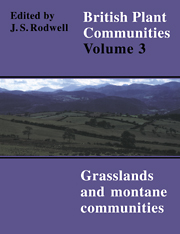Book contents
- Frontmatter
- Contents
- List of Figures
- Preface and Acknowledgements
- Preamble
- Mesotrophic Grasslands
- Community Descriptions
- Calcicolous Grasslands
- Community Descriptions
- Calcifugous Grasslands and Montane Communities
- Community Descriptions
- Index of Synonyms to Grasslands and Montane Communities
- Index of Species in Grasslands and Montane Communities
- Bibliography
MG5 - Cynosurus Cristatus-Centaurea Nigra Grassland Centaureo-Cynosuretum Cristati Br.-Bl. & Tx 1952
Published online by Cambridge University Press: 04 July 2020
- Frontmatter
- Contents
- List of Figures
- Preface and Acknowledgements
- Preamble
- Mesotrophic Grasslands
- Community Descriptions
- Calcicolous Grasslands
- Community Descriptions
- Calcifugous Grasslands and Montane Communities
- Community Descriptions
- Index of Synonyms to Grasslands and Montane Communities
- Index of Species in Grasslands and Montane Communities
- Bibliography
Summary
Synonymy
Dairy Pastures Stapledon 1925; Third-Grade Ryegrass Pastures Williams & Davis 1946; Rothamsted Plot 3 Brenchley rev. Warington 1958; Ridge and Furrow Old Meadow Duffey et al. 1974; Lolio-Cynosuretum luzuletosum Birse & Robertson 1976 p.p.; Calcareous clay pastures Ratcliffe 1977; Calcareous loam pastures Ratcliffe 1977 p.p.; Trifolio-Agrosto-Festucetum Evans et al. 1977 p.p.; Festuco-Centaureo-Brizetum Jones unpub. p.p.
Constant species
Agrostis capillaris, Anthoxanthum odoratum, Centaurea nigra, Cynosurus cristatus, Dactylis glomerata, Festuca rubra, Holcus lanatus, Lotus corniculatus, Plantago lanceolata, Trifolium pratense, T. repens.
Rare species
Cirsium tuberosum.
Physiognomy
The Centaureo-Cynosuretum is a dicotyledon-rich grassland of somewhat variable appearance: it may have a tight, low-growing sward or comprise a fairly lush growth up to 60 cm tall. The most frequent grasses are the fine-leaved Festuca rubra, Cynosurus cristatus and Agrostis capillaris. None of these is consistently the most prominent species in the community, although each may be abundant and occasionally the three are co-dominant. Anthoxanthum odoratum and the coarser Dactylis glomerata and Holcus lanatus are rather less frequent and usually not so abundant. Lolium perenne and Trisetum flavescens occur throughout but are preferential for particular sub-communities and almost always have low cover. Briza media is a distinctive occasional easily overlooked in early sampling. Arrhenatherum elatius and Festuca arundinacea are uncommon but their robust tussock habit may make them conspicuous. Carices may be abundant in some stands with occasional records for Carex caryophyllea, C.flacca, C. panicea and C. hirta.
Dicotyledons always comprise a substantial proportion of the herbage and exceptionally may account for 95% of the cover. Among these, legumes and rosette hemicryptophytes are particularly prominent. Lotus corniculatus, Plantago lanceolata and Trifolium repens are the most frequent and generally the most abundant species, with T. pratense and Centaurea nigra rather less so. Other species frequent throughout are Ranunculus acris, R. bulbosus, Rumex acetosa, Hypochoeris radicata, Taraxacum officinale agg., Achillea millefolium, Prunella vulgaris and Leontodon autumnalis. In particular stands Leontodon hispidus, Primula veris, Leucanthemum vulgare (e.g. Birks 1973) and Rhinanthus minor may be prominent. Severe infestation with R. minor may greatly reduce the vigour of the grasses and give rise to a sward in which rosette species are dominant.
- Type
- Chapter
- Information
- British Plant Communities , pp. 60 - 66Publisher: Cambridge University PressPrint publication year: 1992



